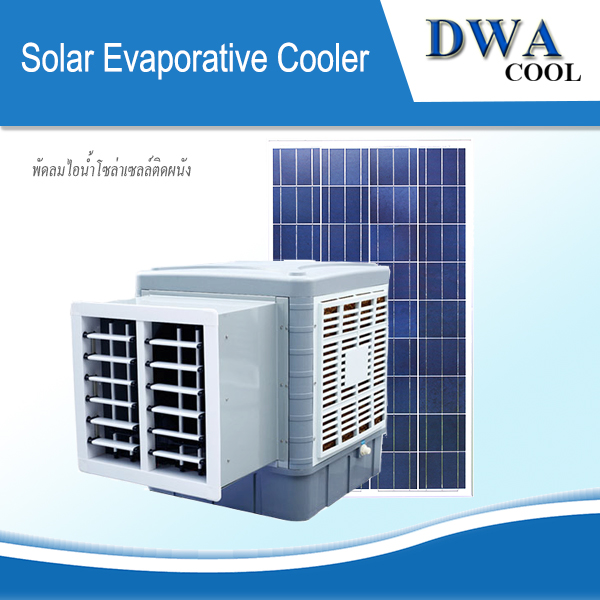A solar air cooler is powered by the sun. It gets its energy from the sun, as the name implies. Its working mechanism is distinct from that of a traditional evaporative air cooler, and it outperforms a solar air conditioner. The solar energy from the sun is transformed into chemical energy and stored in a battery. This battery then serves as the cooler’s power supply. Its simple mechanism and cost-effective operation make it an easy choice for practically everyone. It is especially useful in rural areas where there would be no electricity.
The Working Principle of a Solar Air Cooler
The evaporative cooling technique is used by a solar air cooler. This is the most cost-effective, environmentally friendly, and energy-efficient cooling solution. To understand the fundamental principle, imagine yourself leaving the pool at the height of summer. The water droplets on your skin evaporate as the hot breeze hits you. This evaporation reduces the ambient temperature, making you feel cool and comfortable.
When the solar air cooler powers on, hot air from outside is drawn inside via the wet curtains (cooling medium). The water on the moist pads is evaporated by the hot air. By absorbing heat, water evaporation lowers the temperature of the air. As a result, the fan’s emitted air is clean and cool.
Solar air coolers find great utility in several fields like industries, workshops, etc. The solar cooler has gained a lot of popularity due to its rugged, economical, and environmentally friendly design. It has got an ever-increasing demand in the USA, China, Europe, Africa, Middle East, Asia, etc.
Solar Cooler Vs Solar Air conditioner
To compare a solar cooler to an air conditioner, we must first comprehend its fundamental concepts. The sub-paragraphs that follow explain how these appliances function and other important details
The two types of solar air conditioners are as follows:

Solar thermal hybrid air conditioners
This type of air conditioner operates on the sun energy theory. The compressor, which is powered by solar energy, controls the refrigeration process. The remainder of the electrical components and fans are powered by electricity.

Solar PV hybrid air conditioners
When sunlight hits the solar panel, the air conditioner generates electricity. However, if there is no or only a little sunshine, the air conditioner will draw power from the transmission line. As a result, this system is appropriate for usage throughout the day in places such as workplaces, hospitals, shopping malls, and so on.
There are two types of solar coolers:
(1) 100% DC Coolers
For operation, this cooler makes use of a solar PV panel that is powered by a battery. The battery is discharged by the DC 12/24 V solar air condition. When completely charged, the battery may operate for 8, 12, 18, or 24 hours. A battery, a solar PV panel, and a charge controller are required to operate off the grid.
This type of cooler has been designed specifically for places where there is no electricity. It can work 100% on solar power.
It runs entirely on DC power, with no requirement for AC or a DC converter. It is entirely solar-powered. Solar energy is a sustainable and environmentally friendly source of energy. As a result, it is an extremely eco-friendly and energy-saving device.
Benefits:
– Requires lower grid
– Cost of electricity is reduced
– Can be used in the absence of electrical power
– Greenhouse gas emissions are very less

(2) AC/DC Cooler
Solar air coolers can transition between solar cell (PV) and alternating current (AC) technology, which means they can utilize either solar energy or battery power depending on the situation. The technology can charge its batteries using sunlight-generated power. This happens when the system is in hybrid mode. When this mode is switched off, energy is drawn from the backup batteries. Simultaneously, it continues to charge the batteries through AC power.
Features:
– Dual power
– Priority to solar energy
– Dynamic adjustment
Advantages:
– Saves electricity
– Maximum working ability 95%
– Average working ability 70%
– Can be installed easily
Benefits:
– Reduces the cost and use of electricity
– No special installation is required
– Keeps a dynamic proportion between solar power and regular electricity
– Can operate on electricity in the absence of solar energy
– Acts as a DC inverter to use electricity in the absence of sunlight
What is the solar cooler Advantage and Disadvantages
Advantages
The solar air cooler is a great choice for almost all types of users. It’s ideal for areas where power cuts are frequent or where there’s no electric power. Being available in various sizes, it suits industrial usage as well as individual household use. Some of the most noted benefits of the Solar cooler are
– It uses solar energy and has a minimal running cost.
– It saves electricity and has no carbon footprint, which makes it highly Eco-friendly.
– It’s easy to use and handle with a simple design.
– With simple and cheap components, it has very less maintenance expenses.
– Its initial cost is quite low.
Disadvantage
Because of the solar cell mechanism, the initial investment is larger than that of conventional fans. However, if you look at the long term, there will be a break-even point in 3-5 years.
- By: DWA COOL
- Tags: solar air cooler, air purify, air quality index, solar air, DC cooler, Solar Evaporative Cooler
- 0 comment
Leave a Reply






